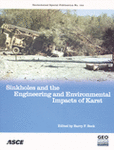Essential Elements of Estimating Engineering Properties of Karst for Foundation Design
Publication: Sinkholes and the Engineering and Environmental Impacts of Karst
Abstract
Understanding the engineering behavior of karst is different from the theory and practice that applies to residual soils or weathered rock formations. Weathered limestone in karst terrane does not behave similar to weathered granite, for example. In the last twenty years foundation problems in karst have kept pace with the rate of development in the Southwest Florida region. Recent problems with the settlement of piers on the Cross-Town Expressway in Tampa have highlighted the need for better subsurface exploration and design methods for foundations in karst terrane. The cost of retrofitting the caissons on this project has added about 30% to the original cost of the project. This experience has proved that in-situ geotechnical testing methods do not adequately assess the geological conditions and in-situ geophysical tests do not adequately define the engineering properties. Foundation design for light structures in karst varies dramatically from those for heavy structures. The differences between the elements of designing foundations for light and heavy structures are not a matter of scale but of understanding the engineering properties of karst. This paper illustrates with examples the essential elements of estimating engineering behavior for large infrastructure projects and heavily loaded structures. At the least, all of the following elements appear essential for heavily loaded structures: a geophysical survey; in-situ geotechnical sampling and strength tests; proper classification of the soil samples, limestone and the weathered limestone; identification of regional hydrogeological and geological features to evaluate the potential for the development of dolines; a reliable method of estimating foundation behavior with specific reference to the location of the foundations; reliable means of evaluating the design of the foundations, and monitoring the foundation behavior. In contrast, the design of lightly loaded structures in karst requires two major components—settlement control and the potential for the development of dolines. Foundation design essentially requires a proper evaluation of the soils and weathered limestone formations. This paper defends the use of the Standard Penetration Test and Cone Penetrometer tests as being adequate for estimating the engineering properties of light structures and recommends the use of Electrical Resistivity or Multiple Analysis of Surface Waves as the most appropriate tests for evaluating the behavior of karst. The paper concludes that expensive errors could be avoided by establishing minimum standards of tests for large projects. Such a protocols do not exist in the private or public sector projects. The author proposes adopting the minimum standards for specific projects such as highways, bridges and tall buildings.
Get full access to this chapter
View all available purchase options and get full access to this chapter.
Information & Authors
Information
Published In
Copyright
© 2005 American Society of Civil Engineers.
History
Published online: Apr 26, 2012
Authors
Metrics & Citations
Metrics
Citations
Download citation
If you have the appropriate software installed, you can download article citation data to the citation manager of your choice. Simply select your manager software from the list below and click Download.
